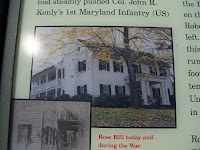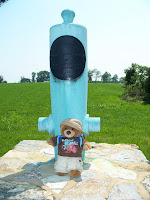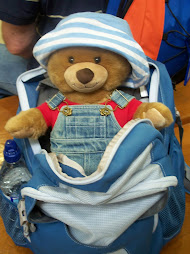Thursday, July 31, 2008
Books Purchased 5 and Books Wanted
That's it. Just one book. Ms. Edwards did see three other books she wanted:
1920 The Year of The Six Presidents - David Pietrusza
Unknown Soldiers - Neil Hanson
Who's Buried in Grant's Tomb - Brian Lamb
Steeles Tavern - McCormick Farm
 While driving to Lexington, Ms Edwards and I saw a sign for McCormick Farm. We thought that we could go and check it out.
While driving to Lexington, Ms Edwards and I saw a sign for McCormick Farm. We thought that we could go and check it out. - Cyrus was 22 years old at the time that he demostronstrated the world's first successful mechanical reaper in fields near his farm. (Walnut Grove)
- The McCormick Reaper harvested grain five times faster with a fraction of the physical effort.
- This happened in July of 1831.
Below is a maker to Cyrus McCormick. On the stone it says "Cyrus H. McCormick inventor of the reaper was born on this farm Feb. 15, 1809. Here he completed the first practical reaper in 1831. V.P.T. Student Branch American Society of Agricultural Engineers 1928."

Below is a picture of a reaper. It was a horse-drawn farm implement to cut small grain crops.

Below is a piece of a poster that Ms. Edwards took a picture of. It says the following:
"McCormick's seven basic principles were as follows:
1. The straight knife with serrated edge and reciprocal or vibrating motion which cuts the grain. 2. Finger or guards extending from the platform to prevent the grain from slipping sideways while being cut. 3. The revolving reel which holds the grain against the knife and lays the cut stalks on the platform. 4. Platform behind the knife for receiving the cut grain and holding it until raked off. 5. The master wheel which carries most of the weight of the machine and, through ground traction, furnishes power to operate the reel and the knife. 6. Forward draft from the right or stubble side by means of shafts attached in front of the master wheel. 7. A divider on the left side to seperate the grain to be cut from that to be left standing.

Here is a picture of me at the farm :) Below is a close up :)


Staunton - Woodrow Wilson Presidential Library and Birthplace

Ms. Edwards and I drove to Staunton Virginia and stopped at our second Presidential Library of the year. The first library we visited was in Boston Mass. (John F. Kennedy). We were unable to see the second floor to the house due to the fact that they were renovating.
- Woodrow Wilson name was actually Thomas Woodrow Wilson. He dropped Thomas (Tommy) when he was in college. Woodrow was his mother's maiden name.
- He was the third child in a family of four. He had two older sisters.
- His father was a Presbyterian minister.
- He only lived in the house pictured above for about the first year of his life.
- Wilson's family owned slaves.
- Wilson was raised in Augusta Georgia
- He did not learn to read until he was around 12 years old.
- Graduated Princeton College in 1879
- Attended one year of law school and passed the bar in Georgia.
- Received a doctorate in political science from Johns Hopkins University. (The only President to actually earn one the hard way)
- He was married to Ellen Louise Axson and they had three daughters that survived to adulthood. His wife died during his first term as president.
- He married Elanor R. Wilson.



Charlottesville - Monticello

Ms. Edwards and I went to Monticello the home of the third President of the United States Thomas Jefferson. It was a rainy day and Ms. Edwards wouldn't let me come out of the backpack. I was able to peak out though when she wasn't looking.
- Monticello was named by Thomas Jefferson. It means "little mountain" in Italian.
- Construction was started on Monticello in 1768.
- Jefferson was the archeticut of his home.
- He was inspired to make changes to his designs through his trips to Europe.
- Jefferson sold his personal library to the Government after the War of 1812. This was how the Library of Congress was started. He then started his library all over again.
- Jefferson kept extensive records about everything that occurred at Monticello and everyone who lived there.
- We were unable to see the second floor becuase of fire code regulations :(
- Thomas Jefferson's bed was in a unique location. It was in the wall. He over his head was a storage area for his clothing that had to be reached by a ladder.
- Thomas Jefferson was interested in many things.
- Jefferson's happiest years occurred while at Monticello.
- Jefferson kept a very busy and structured life at Monticello.
- I think Ms. Edwards could give Thomas Jefferson a run for his money when it comes to the amount of books they own.
Below is one of the flowers that Ms. Edwards took a picture of. Thomas Jefferson had an amazing flower garden and kept amazing records about what was planted and where items were planted.
Ms. Edwards decided to walk to Jefferson's grave and back to her vehicle at the visitors center. Here is the pathway that she walked down to get to Jefferson's grave.
Here is the grave marker for Thomas Jefferson. It says the following: "Here was buried Thomas Jefferson Author of the Declaration of American Independence of the Statute of Virginia for Religious Freedom and Father of the University of Virginia.
Ms. Edwards purchased a dvd that shows pictures of the inside of the house. Jefferson had some really unique rooms and features in the rooms. He was a man who was very innovative with what was available during the time he lived there.
Lexington - Stonewall Jackson House

The last thing that Ms. Edwards and I did today was to visit Stonewall Jackson's House in Lexington. We weren't able to take pictures of the house. We were able to see the basement and the first floor of the house. We were unable to see the second floor. We started our tour in a room in the basement. There was a small display about Jackson's life and career. We also watched a short video over Jackson's life while he lived in the house pictured above.
Some interesting things we learned about Jackson:
- This was the first historical site that we visited that referred to him as Thomas Jonathan Jackson and not General Jackson or "Stonewall" Jackson.
- Jackson did not grow a beard until the Civil War. He was generally a clean shaved gentlemen.
- Thomas's sister ws born the day after his father died (Laura)
- Jackson was a slave owner. He has servents in his house and three that worked a farm outside of Lexington.
- 1842 - Jackson entered West Point. During the first year he placed towards the bottom of the class. By the time he graduated he was 17th. He graduated in 1846.
- Jackson was not a popular teacher - he memorized his lectures and was not able to answer students questions. (Virginia Military Institute)
- He taught Sunday school classes at a Presbyterian Church
- Jackson and his second wife (Mary) lost a baby before having their daughter.
- Jackson purchased his house in Lexington in 1859.
- Jackson died at the age of 39.
The house had a lot of interesting artifacts that were connected to the Jackson family. Surprisingly the Jackson's bedroom was on the first floor and all the guestrooms were on the second floor. Jackson liked to keep to a strict schedule while in Lexington. He was also very concerned about the types of foods he ate. He liked to keep a very bland diet.
I was really surprised at how old Jackson was when he died. He seemed a man who was extremely wise for his age. He was also a man who had a lot of responsibilites on his shoulders and a lot of deaths to deal with. He appearance makes him look order then 39. It is really surprising what he accomplished in his too short a life.Below is a picture that was taken of Jackson. It shows that he liked a clean faced look.

ooo
(__)
Wednesday, July 30, 2008
Books Purchased 4
"Give the enemy no rest!" Sheridan's 1864 Shenondoah Campaign - Shenandoah Valley Battlefields National Historic District
Cadets At War - Susan Provost Beller
Behind The Blue and Gray: The Soldier's Life In The Civil War - Delia Ray
ooo
(__)
Books Purchased 3
So here is what she purchased today:
Yanks, Rebels, Rats, and Rations: Scratching For Food in Civil War Prison Camps - Patricia B. Mitchell
The Cornfield Trial: September Harvest of Death - National Park Service
Union Advance Trial: Attack and Defense of the Burnside Bridge - National Park Service
Antietam Remembered: A Walking Tour - National Park Service
The Final Attack Trial - National Park Service
Witness To Battle - National Park Service
Antietam National Cementary - National Park Service
Southern Ladies' Civil War and Antebellum Fashions - Sarah E. Mitchell
Battle of Cedar Creek Self Guided Tour
Home Front Regiment 1861-1865 - Patricia Mitchell
The Berkeley Journal: Berkeley County in the Civil War - Berkeley County Historical Society
The Berkeley Journal: Belle Boyd - Berkeley County Historical Society
A Separate Battle: Women and The Civil War - Ina Chang
Guess you can tell which battlefield she liked the most.
ooo
(__)
Tuesday, July 29, 2008
Martinsburg - Belle Boyd House Museum
We arrived at the Belle Boyd House and we had a tour of the house.


I can honestly say that I have never seen a house like this. The shapes of the rooms upstairs were very unique. There were so many nooks and odd shaped room. It was designed very interestingly. I would hate to be the one who would have to clean. The house was supposed to be torn down. The Berkely County Historical Society purchased it on August 17, 1992.
If someone wanted to visit this house they would hear the story of Belle Boyd and would see some artifacts that would have existed in the time of Belle. There were exhibits to other events and to people who were from the area of Berkely County.
There was one room for a baseball player known as Hack Wilson. I have no idea who he was but there was a room dedicated for him.
There were also rooms for WWI, WWII, a desk from the Pentagon, a purple heart and much more.
Facts I learned about Belle Boyd House and Belle Boyd:
- Born in Berkeley County, West Virginia on May 9, 1843.
- Christened Marie Isabella Boyd.
- Her parents were Benjamin Reed Boyd and Mary Glenn Boyd.
- Belle's family moved to Martinsburg around the time she was seven years old.
- Belle was expelled from school and was sent to Mt. Washington School in Baltimore, Maryland in 1856.
- Belle began her life as a spy in 1858.
- Her father joined the Confederate Army.
- July 4, 1861 - Belle shot a soldier who broke into her parents house and insulted her mother.
- She went to live with her Aung Fanny Stewart in Front Royal at a small boarding house.
- She gave information to General Jackson at Front Royal.
- Belle ended up marrying an union soldier named Lieutenant Harding (New York). He agreed to join the Confederate army.
- Belle went to Canada and then London. (An agreement she made to leave the country with the government)
- Lieutenant Harding was arrested and imprisoned and Belle Boyd sent a letter to Lincoln threatened to share information that she knew about Washington if her husband wasn't released.
- Harding was released and went to London. They both acted on stage.
- Belle is the first Virginian to publish a book abroad. She was also the first actress abroad from West Virginia.
- She published Belle Boyd in Camp and Prison in 1865.
- Belle Boyd returned to New York in 1867 with her daughter. She divorced her husband.
- She married John Edmond Hammond and they had four children.
- At the age of 43, Belle married her third husband. His name was Hugh High and he was 25 years old.
- She died on Junie 11, 1900.
Cedar Creek Battlefield



Front Royal - Battle Field Tour
- The battle took place on May 23, 1862.
- Union Commander was Col. John R. Kenly
- Confederate Commander was Stonewall Jackson
- Union Forces - 1,063 Union Loses - 904
- Confederate Forces - 3000 Union Loses - 56
- This was considered a win for the Confederacy
- This was part of Jackson's Valley Campaign. (1st Kernstwon, McDowell, Princeton Courthouse, Front Royal, 1st Winchester, Cross Keys and Port Repubic)
First Stop: Asbury Chapel.
- This is were the Confederate advance halted. They were looking for a different route into town.
- It is also the spot we General Jackson decided to sent the 1st Maryland into battle. The reason they were chosen to go in first was because they would be facing the 1st Maryland on the Federal side. This was going to be a battle of "brother against brother" in the true sense of the word.

NOTE: From Asbury Chapel I traveled on a road called Rocky Lane. This road lived up to its name. While driving down this road I thought about how much Ms. Edwards father would enjoy driving down this road. He seems to enjoy finding these kinds of roads and here we are following an audio cd. The road was two ways. In some areas I don't see how it would have been possible.
Second Stop: Belle Boyd
- For this location I had to stop at the grounds of a church. At this location was a marker that described what occurred at this site.
- General Jackson stopped his troops in this location to put them into battle formation.
- It was here that Belle Boyd gave a report on the Union troops numbers and activities. She encouraged an immediate attack on Front Royal.

Stop Three: Prospect Hill Cementary
- Confederate artillery was set up too late to be able to help in the battle.
- The cannons at this location had no role in the Battle of Front Royal
- Below is a picture of a monument for the Confederate dead as well as graves of Confederate soldiers.

Stop Four: The Courthouse
- Fighting happened here street by street and building by building.
- This battle was fought by troops on both sides from the state of Maryland.

Stop Five: Bel Air
- The home of Lucy Buck's family.
- She kept a journal that helped historians determine what occurred at this battle.

Stop Six: Rose Hill
- At this location Col. Kenly set up his defensive location.
- On Rose Hill was a house owned by Widow Richardson and her three daughters. Her son, William had been wounded at Williamsburg.
- It was Sue Richardson's diary that helped historians determine what occurred at this sight.

Stop Seven: Richardson's Hill
- Union forces made their defensive stand against the advancing Confederates.
- Kenly made an effort to hold back Jackson's forces.
- He was trying to give General Banks time to withdraw troops from Strasburg.
Stop Eight: The Bridges
- At this stop there wasn't much to see. Ms. Edwards took a picture of me sitting on the bench by the marker. I think that the trees grew up to far for you to see what the intended focus of this location was. I think I make a good substitute though.
- At this location Jackson's troops arrived. They saw smoke and fire coming from the bridges that were burning.
- The Confederates were slowed down.


Stop Nine: Guard Hill
- In this location is Dr. Kenner's House.

Stop Ten: Fairview
- Col. Kenly and his troops retreated towards Winchester.
- They were overtaken by Lt. Col. Thomas Flournoy's 6th Virginia Calvary.
- The battle ended at Fairview.

























